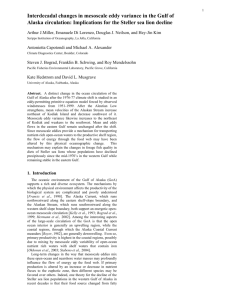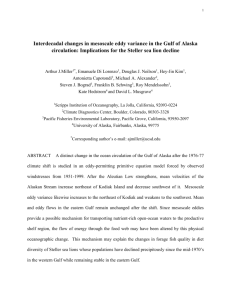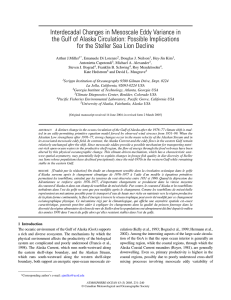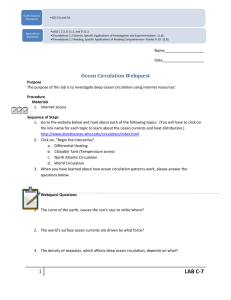GOA_GRL_revised_final
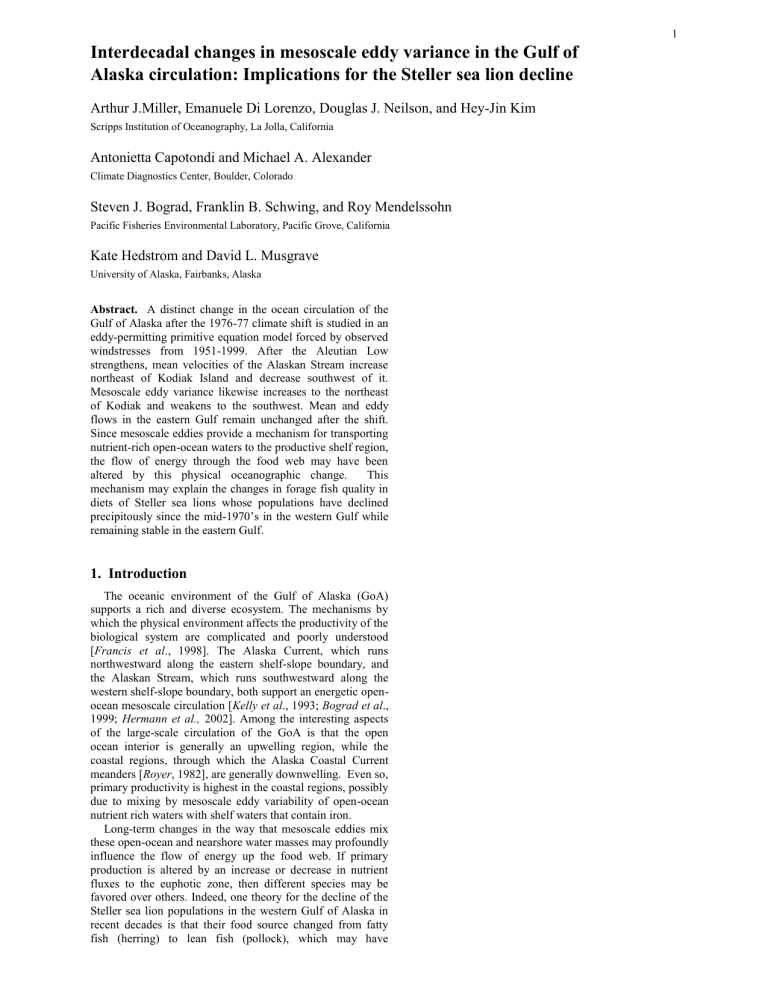
Interdecadal changes in mesoscale eddy variance in the Gulf of
Alaska circulation: Implications for the Steller sea lion decline
Arthur J.Miller, Emanuele Di Lorenzo, Douglas J. Neilson, and Hey-Jin Kim
Scripps Institution of Oceanography, La Jolla, California
Antonietta Capotondi and Michael A. Alexander
Climate Diagnostics Center, Boulder, Colorado
Steven J. Bograd, Franklin B. Schwing, and Roy Mendelssohn
Pacific Fisheries Environmental Laboratory, Pacific Grove, California
Kate Hedstrom and David L. Musgrave
University of Alaska, Fairbanks, Alaska
Abstract. A distinct change in the ocean circulation of the
Gulf of Alaska after the 1976-77 climate shift is studied in an eddy-permitting primitive equation model forced by observed windstresses from 1951-1999. After the Aleutian Low strengthens, mean velocities of the Alaskan Stream increase northeast of Kodiak Island and decrease southwest of it.
Mesoscale eddy variance likewise increases to the northeast of Kodiak and weakens to the southwest. Mean and eddy flows in the eastern Gulf remain unchanged after the shift.
Since mesoscale eddies provide a mechanism for transporting nutrient-rich open-ocean waters to the productive shelf region, the flow of energy through the food web may have been altered by this physical oceanographic change. This mechanism may explain the changes in forage fish quality in diets of Steller sea lions whose populations have declined precipitously since the mid-1970’s in the western Gulf while remaining stable in the eastern Gulf.
1. Introduction
The oceanic environment of the Gulf of Alaska (GoA) supports a rich and diverse ecosystem. The mechanisms by which the physical environment affects the productivity of the biological system are complicated and poorly understood
[ Francis et al ., 1998]. The Alaska Current, which runs northwestward along the eastern shelf-slope boundary, and the Alaskan Stream, which runs southwestward along the western shelf-slope boundary, both support an energetic openocean mesoscale circulation [ Kelly et al ., 1993; Bograd et al .,
1999; Hermann et al., 2002]. Among the interesting aspects of the large-scale circulation of the GoA is that the open ocean interior is generally an upwelling region, while the coastal regions, through which the Alaska Coastal Current meanders [ Royer , 1982], are generally downwelling. Even so, primary productivity is highest in the coastal regions, possibly due to mixing by mesoscale eddy variability of open-ocean nutrient rich waters with shelf waters that contain iron.
Long-term changes in the way that mesoscale eddies mix these open-ocean and nearshore water masses may profoundly influence the flow of energy up the food web. If primary production is altered by an increase or decrease in nutrient fluxes to the euphotic zone, then different species may be favored over others. Indeed, one theory for the decline of the
Steller sea lion populations in the western Gulf of Alaska in recent decades is that their food source changed from fatty fish (herring) to lean fish (pollock), which may have
1
adversely affected their metabolism [ Trites and Donnelly ,
2002].
Long-term changes in mesoscale eddy variance, however, have never been identified in the GoA due largely to limited observations. Lagerloef [1995] identified broad-scale changes in the circulation throughout the 1970’s and 1980’s using available hydrographic data. But local timeseries of crossshelf hydrographic surveys may alias mesoscale eddies.
Hence, we turn to a numerical model of the GoA circulation to determine if changes in mesoscale eddy variance may have occurred in response to the strengthening of the Aleutian Low after the 1976-77 climate shift [ Miller et al ., 1994a].
Our objective is to address two unexplained key issues about the Steller sea lion decline. The first is the temporal issue, in that the western populations, living in and around
Prince William Sound though the Aleutian Island chain, declined precipitously after the 1976-77 climate shift. Was this co-incident with a strong change in ocean circulation and associated mesoscale variability in this region? The second is the spatial issue, in that the eastern populations, living in and around southeastern Alaska and British Columbia, remained stable over this same time period. Is there a strong east-west asymmetry in the GoA ocean circulation changes that occurred after 1976-77 climate shift? We address these questions in targeted numerical experiments in which we analyze the runs for changes in eddy statistics that occurred after the climate shift.
2. Ocean model hindcasts
We use the Regional Ocean Modeling System (ROMS), which is a generalized sigma-coordinate, hydrostatic, primitive equation model with a free surface [ Moore et al .,
2004]. The model domain is restricted to the GoA north of
50N with all straits through the Aleutian Islands closed. The topography is smoothed version of the Smith and Sandwell
[1997] dataset (Figure 1). The resolution is approximately
0.25
o longitude and and 0.17
o latitude, corresponding to roughly 15 km resolution in the central basin. Horizontal friction is treated implicitly in the differencing scheme, where it occurs as a high-order lateral friction [ Shchepetkin and
McWilliams , 1998]. Vertical mixing is via the K profile parameterization [ Large et al ., 1994].
Open boundary conditions along the southern and southwestern boundaries follow the procedure of
Marchesiello et al . [2001], which combines a relaxation to
Levitus climatology on inflow with a radiation condition on outflow. Surface heat fluxes and surface fresh water fluxes are modeled as a relaxation to the climatological seasonal cycle of sea-surface temperature and salinity, respectively.
The model is first spun-up with climatological winds for 10 years. The model is then forced over the 1950-1999 time period by monthly-mean wind stresses taken from the
NCEP/NCAR re-analysis. No other anomalous forcing in surface fluxes or boundary conditions is included. The model run therefore can only be examined for dynamic adjustment to the wind stress changes, which is the dominant large-scale forcing function for the GoA.
Wind stress curl is expected to be the most important forcing function for the large-scale variability of the GoA circulation [ Kelly et al., 1993]. The first and second empirical orthogonal functions (EOFs) and principal components (PCs) of wind stress curl in the model domain are shown in Figure
2. EOF1 exhibits a sharp decadal-scale change in the late
1970’s consistent with the 1976-77 climate shift of sea level
2
pressure. Lagerloef [1995] also identified this pattern of variability, although it occurred as the 2 nd EOF in his analysis of COADS winds. It was also the dominant post-shift pattern found by Capotondi et al . [2004] who noted it represents a strengthening of the mean pattern of wind stress curl forcing.
EOF2 does not exhibit decadal-scale changes. Both EOFs contain substantial interannual variability, which may obscure signals on decadal timescales.
3. Results
The analysis of the model hindcasts focuses on horizontal surface velocity fields since these are the most sensitive indicator of changes in the GoA circulation It is especially illuminating to consider ten-year epochs around the 1976-77 climate shift. The periods 1967-76 and 1979-88 are chosen as representative of pre- and post-shift conditions based on PC1 of wind-stress curl of Figure 2 and allowing a two-year adjustment timescale after the shift [ Deser et al ., 1999]. The results are not sensitive to exact choice of epoch dates.
Figure 3 shows the mean surface currents for the two epochs along with the difference field. Both before and after the shift, the Alaskan Stream is clearly present and flows southwestward along the western shelf-slope boundary of the domain. The Alaska Current is also evident before and after the shift, flowing northwestward along the eastern shelf-slope boundary of the GoA. After the shift, however, the Alaskan
Stream is strengthened considerably in the northwest part of the GoA (north of 56 o domain (south of 55 o
N) and weakened in the southwestern
N). The strengthening is so intense in the northwest that what appears to be an inertial recirculation occurs southeastward of the Alaskan Stream. The increase in the strength of the Alaskan Stream is consistent with coarse resolution model results of Capotondi et al . [2004].
This change in the mean strength of the Alaskan Stream over decadal timescales would be expected to alter the stability properties of the flow field and change the mesoscale eddy variance distribution. Figure 4 shows the surface current velocity variance for the two epochs along with the difference in variance after the climate shift. Before the shift, mesoscale eddy variance is highest southeast of Kodiak Island and along the Alaskan Stream to the southwest of Kodiak. After the shift, mesoscale eddy variance increases sharply in the northwestern GoA and decreases precipitously to the south and west of Kodiak Island. The consequences of this change will include altering the cross-shelf/slope mixing of water masses of the open ocean and shelf regions.
The mean flows of the Alaska Current in the eastern GoA
(Figure 3), in contrast, are nearly unchanged after the shift.
Likewise, the surface velocity variance is only weakly altered, being reduced slightly compared to pre-shift conditions
(Figure 4). Hence, an east-west asymmetry occurs in the GoA circulation response to the altered Aleutian Low.
4. Discussion
An eddy-permitting ocean model hindcast reveals distinct changes in the circulation of the Gulf of Alaska after the
1976-77 climate shift. The increase in the strength of the
Aleutian Low drives a more energetic mean and eddy circulation in the northwest GoA. In the western GoA, south and west of Kodiak Island, however, the mean and eddy circulation is weaker. In the eastern GoA, the Alaska Current remains relatively unchanged after the shift.
3
These novel results offer a possible explanation for changes in the oceanic ecosystem that may have affected the food supply for the Steller sea lion populations that declined precipitously in the western GoA beginning in the late 1970’s.
The mesoscale eddy fields around the Alaskan Stream mix open-ocean waters, which tend to be rich in basic nutrients like nitrate, with near-coastal waters, which tend to include the limiting nutrient iron. If the amount of mixing is altered for extended time periods, as found here in an ocean hindcast, then the structure of the food chain may be altered. This may be a possible mechanism for the change in distributions of herring and pollock population [ Hinckley et al., 2001]. This change is visible in dietary changes of Steller sea lion populations over the same time period, from high quality fish
(e.g., herring) to low quality fish (e.g., pollock). The less fatty pollock-based diet has been hypothesized to weaken the ability of these animals to nurture healthy offspring [ Rosen and Trites , 2000].
While these modeling results are suggestive, they are not conclusive. A lack of sufficiently dense space-time sampling of ocean hydrography prohibits a definitive data analysis that may support these modeling results [ Stabeno and Hermann ,
1996]. The limited data analysis of Lagerloef [1995], in fact, suggests that the Alaskan Stream weakened north of 55 o N after the shift, which apparently contradicts our model results.
We are presently re-assessing the data analysis procedure used by Lagerloef to determine if the sparseness of data in the coastal regions may have inadvertently allowed the objective analysis contours to close around open ocean features, forming spurious boundary layers. Indeed, the open-ocean interior flows of the Lagerloef analysis have many consistencies with the model solutions. Moreover, one would intuitively expect a strengthening of the boundary currents after increasing the mean amplitude of the wind stress curl.
Coarse resolution models [ Capotondi et al ., 2004; Miller et al ., 1994b] support this dynamical intuition.
The occurrence of a mean surface northeastward countercurrent seaward of the Alaskan Stream, which intensifies after the shift, is another interesting component of the model solution. While there is no consensus in the literature whether this is a real feature of the GoA circulation, there are many indications that it is. Reed [1984] and Royer and Emery [1987] present hydrographic sections with dynamic height calculations across the shelf-slope system south of the Aleutians that suggest a seaward countercurrent.
Bograd et al . [1999] find a similar indication in their surface drifter analysis. Lastly, the countercurrent in the model clearly follows the topographic contours of the southern slope of the
Aleutian trench, which agrees with the observed topographic location of the countercurrent location found by Onishi and
Otani [1999].
Wind stress curl is thought to be the dominant forcing function for the large-scale flows of the GoA, so our contention that wind stress will largely control the circulation changes after the shift is likely correct. However, several other forcing effects were not considered in this simulation.
First, no changes to the open-ocean boundary condition were allowed in the southern boundary or along the numerous straits in the Aleutian Island chain. These inflows may alter the broad-scale flows to some degree, especially in the region of the Alaska Current, which has been linked to interannual changes of interior flows [ Strub and James , 2003] and poleward propagating coastally trapped disturbances [ Strub and James , 2002; Melsom et al., 2003]. Second, no changes in the surface heat fluxes or fresh water fluxes were included.
Buoyancy fluxes may affect the upper water column stability
4
properties, which may affect mesoscale eddy formation.
Long-term changes in streamflow runoff may affect the
Alaska Coastal Current, which is largely forced by the mean runoff [ Royer , 1982]. How these changes might influence and interact with the open-ocean eddy variations is not apparent and will require additional experimentation
[ Hermann and Stabeno , 1996; Okkonen et al ., 2001]. Lastly, the resolution of the model is only 16km, which is good compared to coarse resolution models but poor compared to the internal deformation radius in the GoA. Higher resolution models need to be examined to determine if these results are robust [ Hermann et al ., 2002].
Nonetheless, the model results are plausible and dynamically consistent with changes in atmospheric circulation that followed the 1976-77 climate shift of the
Pacific Ocean. A better understanding of how the ocean ecosystem responds to these physical circulation changes is perhaps the greatest ensuing challenge. As observations of the physical-biological system increase, greater ability to model the past changes in the system will follow. The results here are a first step towards that goal.
Acknowledgments.
Major funding was provided by the NOAA
CIFAR Program (NA17RJ1231). Additional funding was provided by NSF (OCE-00-82543) and DOE (DE-FG03-01ER63255).
5
References
Bograd, S. J., R. E. Thomson, A. B. Rabinovisch, P. H. LeBlond,
Near-surface circulation of the northeast Pacific Ocean derived from WOCE-SVP satellite-tracked drifters, Deep-Sea Res., 46,
2371-2403, 1999.
Capotondi, A., M. A. Alexander, C. Deser, A. J. Miller, Lowfrequency pycnocline variability in the Northeast Pacific, J. Phys.
Oceanogr., sub judice 2004.
Deser, C., M. A. Alexander, M. S. Timlin, Evidence for a winddriven intensification of the Kuroshio Current extension from the
1970s to the 1980s, J. Climate, 12, 1697-1706, 1999.
Francis, R. C., S. R. Hare, A. B. Hollowed, W. S. Wooster, Effects of
Interdecadal climate variability on the oceanic ecosystems of the
NE Pacific, Fish. Oceanogr., 7, 1-21.
Hermanni, A. J., P. J. Stabeno, An eddy-resolving model of circulation on the western Gulf of Alaska shelf .1. Model development and sensitivity analyses, J. Geophys. Res., 101,
1129-1149, 1996.
Hermann, A. J., D. B. Haidvogel E. L. Dobbins, P. J. Stabeno,
Coupling global and regional circulation models in the coastal
Gulf of Alaska, Prog Oceanog, 53, 335-367, 2002.
Hinckley, S., A. J. Hermann, K. L. Mier, B. A. Megrey, Importance of spawning location and timing to successful transport to nursery areas: a simulation study of Gulf of Alaska walleye pollock. ICES
J. Mar. Sci. 58, 1042-1052, 2001.
Kelly, K. A., M. J. Caruso, J. A. Austin, Wind-forced variations in sea surface height in the northeast Pacific Ocean. J. Phy.
Oceanogr.
, 23 , 2392-2411, 1993.
Lagerloef, G. S. E., Interdecadal variations in the Alaska Gyre, J.
Phys. Oceanogr., 25, 2242-2258, 1995.
Large, W. G., J. C. McWilliams, S. C. Doney, Oceanic vertical mixing – A review and a model with a nonlocal boundary-layer parameterization, Rev. Geophys., 32, 363-403, 1994.
Marchesiello, P., J. C. McWilliams, A. Shchopetkin, Open boundary conditions forlong-term integration of regional oceanic models,
Ocean Modelling, 3, 1-20, 2001.
Melsom, A., E. J. Metzger, H. E. Hurlburt, Impact of remote oceanic forcing on Gulf of Alaska sea levels and mesoscale circulation, J.
Geophys. Res., 108, art. no. 3346, 2003.
Miller, A. J., D. R. Cayan, T. P. Barnett, N. E. Graham, J. M.
Oberhuber, The 1976-77 climate shift of the Pacific Ocean.
Oceanography, 7, 21-26, 1994a.
Miller, A. J., D. R. Cayan, T. P. Barnett, N. E. Graham, J. M.
Oberhuber, Interdecadal variability of the Pacific Ocean: Model response to observed heat flux and wind stress anomalies. Clim.
Dyn. 9, 287-302, 1994b.
Moore, A. M., H. G. Arango, E. Di Lorenzo, B. D. Cornuelle, A. J.
Miller, D. J. Neilson, A comprehensive ocean prediction and analysis system based on the tangent linear and adjoint components of a regional ocean model. Ocean Modelling, 7, 227-
258.
Okkonen, S. R., G. A. Jacobs, E. J. Metzger, H. E. Hurlburt, J. F.
Shriver, Mesoscale variability in the boundary currents of the
Alaska Gyre, Cont. Shelf Res., 21, 1219-1236, 2001.
Onishi, H., K. Ohtani, On seasonal and year to year variation in flow of the Alaskan Stream . J. Oceanogr.
, 55 , 597-608, 1999.
Reed, R. K., Flow of the Alaska Stream and its variations, Deep-Sea
Res., 31, 369-386, 1984,
Rosen, D. A. S., A. W. Trites, Pollock and the decline of Steller sea lions: testing the junk-food hypothesis, Can J. Zool., 78, 1243-
1250, 2000.
Royer, T. C., Baroclinic transports in the Gulf of Alaska, 2: A freshwater-driven coastal current. J. Mar. Res. 39 , 251-266, 1981.
Royer, T. C., W. J. Emery, Circulation in the Gulf of Alaska, 1981,
Deep-Sea Res., 34, 1361-1377, 1987.
Shchepetkin, A. F., J. C. McWilliams, Quasi-monotone advection schemes based on explicit locally adaptive dissipation, Mon. Wea.
Rev.
, 126 , 1541-1580, 1998.
Smith, W. H. F., D. T. Sandwell, Global sea floor topography from satellite altimetry and ship depth soundings, Science, 277, 1956-
1962, 1997.
Stabeno, P. J., A. J. Hermann, An eddy-resolving model of circulation on the western Gulf of Alaska shelf .2. Comparison of results to oceanographic observations.
J. Geophys. Res., 101,
1151-1161, 1996.
Strub, P. T., C. James, Altimeter-derived circulation in the largescale NE Pacific Gyres. Part 2: 1997-1998 El Nino anomalies,
Progr. Oceanogr., 53, 185-214, 2002.
6
Strub, P. T., C. James, Altimeter estimates of anomalous transport in the northern California Current during 2002-2002. Geophys., Res.
Lett., 30, art no. 8025, 2003.
Trites, A. W., C. P. Donnelly, The decline of Steller sea lion
Eumetopias jubatus in Alaska: a review of the nutritional stress hypothesis, Mammal Rev., 33, 3-28, 2003.
E. Di Lorenzo, H.-J. Kim, A. J. Miller, and D. J. Neilson, Scripps
Institution of Oceanography, La Jolla, CA 92093-0224. (e-mail: edl, h15kim, ajmiller, or dneilson@ucsd.edu
)
M. A. Alexander, and A. Capotondi, Climate Diagnostics Center,
Boulder, CO 80303-3328.
S. J. Bograd, R. Mendelssohn, and F. B. Schwing, Pacific
Fisheries Environmental Laboratory, Pacific Grove, CA 93950-2097.
K. Hedstrom, and D. L. Musgrave, University of Alaska,
Fairbanks, AK 99775.
(Received March X, 2004; revised XXX, 2004; accepted XXX, 2004.)
MILLER ET AL.: INTERDECADAL CHANGES IN EDDY VARIANCE
MILLER ET AL.: INTERDECADAL CHANGES IN EDDY VARIANCE
MILLER ET AL.: INTERDECADAL CHANGES IN EDDY VARIANCE
MILLER ET AL.: INTERDECADAL CHANGES IN EDDY VARIANCE
7
Title:
Graphic s produc ed by IDL
Creat or:
IDL Vers ion 5.4 (OSF alpha)
Prev iew :
This EPS pict ure w as not s av ed w ith a preview inc luded in it.
Comment:
This EPS pict ure w ill print to a
Pos tSc ript printer, but not to other ty pes of printers.
Figure 1. Bathymetry of the ocean model. Contour interval is 500m, except for additional contours at 100m, 200m, and
300m.
Figure 1.
Bathymetry of the ocean model. Contour interval is 500m, except for additional contours at 100m, 200m, and 300m.
8
Title:
Graphic s produc ed by IDL
Creat or:
IDL Vers ion 5.4 (OSF alpha)
Prev iew :
This EPS pict ure w as not s av ed w ith a preview inc luded in it.
Comment:
This EPS pict ure w ill print to a
Pos tSc ript printer, but not to other ty pes of printers.
9
Figure 2. Principal components (top) of the first (thick) and second (thin) empirical orthogonal functions of the wind stress curl over the 1951-1999 period from the NCEP/NCAR re-analysis. After computing the EOFs from monthly mean fields, the PC’s were smoothed with a 2-year running mean filter. EOF1 (middle) and EOF2 (bottom) of the wind stress curl, explain 26% and 24% of the monthly mean variance, respectively. Values are scaled by 10 10 .
Figure 2.
Principal components (top) of the first (thick) and second (thin) empirical orthogonal functions of the wind stress curl over the 1951-1999 period from the NCEP/NCAR re-analysis. After computing the EOFs from monthly mean fields, the PC’s were smoothed with a 2-year running mean filter. EOF1 (middle) and EOF2 (bottom) of the wind stress curl, explain 26% and 24% of the monthly mean variance, respectively. Values are scaled by 10 10 .
Title:
Graphic s produc ed by IDL
Creat or:
IDL Vers ion 5.4 (OSF alpha)
Prev iew :
This EPS pict ure w as not s av ed w ith a preview inc luded in it.
Comment:
This EPS pict ure w ill print to a
Pos tSc ript printer, but not to other ty pes of printers.
10
Figure 3. Mean surface currents for the 10-year epochs
1967-1976 (top) and 1979-1988 (middle), and the difference between the two epochs (bottom). Currents less than 5cm/s do not receive a vector, and only every 6 th grid point receives an arrow. Magnitude of the current is contoured at 10cm/s intervals.
Figure 3.
Mean surface currents for the 10-year epochs 1967-1976 (top) and 1979-1988 (middle), and the difference between the two epochs (bottom). Currents less than 5cm/s do not receive a vector, and only every 6 th grid point receives an arrow.
Magnitude of the current is contoured at 10cm/s intervals.
Title:
Graphic s produc ed by IDL
Creat or:
IDL Vers ion 5.4 (OSF alpha)
Prev iew :
This EPS pict ure w as not s av ed w ith a preview inc luded in it.
Comment:
This EPS pict ure w ill print to a
Pos tSc ript printer, but not to other ty pes of printers.
11
Figure 4. Variance of the monthly mean surface currents for the 10-year epochs 1967-1976 (top) and 1979-1988 (middle), and the difference between the two epochs (bottom). Variance of the current is contoured at 100cm 2 /s 2 intervals.
Figure 4.
Variance of the monthly mean surface currents for the 10-year epochs 1967-1976 (top) and 1979-1988 (middle), and the difference between the two epochs (bottom). Variance of the current is contoured at 100cm 2 /s 2 intervals.
12
